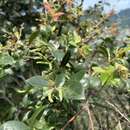Comments
provided by eFloras
This species is used medicinally and to stain cooked rice.
- license
- cc-by-nc-sa-3.0
- copyright
- Missouri Botanical Garden, 4344 Shaw Boulevard, St. Louis, MO, 63110 USA
Description
provided by eFloras
Shrubs or small trees, evergreen, 2–6(–9) m tall, much branched. Twigs inconspicuously angled, pubescent or glabrous; bud scales inconspicuous. Leaves scattered; petiole 2–8 mm, puberulous or glabrous; leaf blade elliptic, rhombic- or lanceolate-elliptic, or lanceolate, rarely obovate, (1.1–)4–9 × (0.7–)2–4 cm, thinly leathery, glabrous, secondary veins 5–7 pairs, barely raised, fine veins conspicuous or not, base cuneate, broadly cuneate, or obtuse, margin plane, denticulate, apex acute, acuminate, rarely rounded or long acuminate. Inflorescences pseudoterminal, racemose, 4–10 cm, densely pubescent, rarely glabrous, many flowered; bracts persistent or caducous, leaflike, lanceolate, 0.5–2 cm. Pedicel ca. 4 mm, densely pubescent or subglabrous. Hypanthium densely pubescent or tomentellate, rarely subglabrous; calyx limb ca. 1 mm, triangular-toothed. Corolla white, rarely reddish, tubular or slightly urceolate, 5–7 mm, densely pubescent; lobes reflexed, triangular. Filaments 2–2.5 mm, densely pilose; anthers 2–2.5 mm, without spurs; tubules 2–2.5 × as long as thecae. Berry 10-pseudoloculed, dark purple, pubescent. Fl. Jun–Jul, fr. Aug–Oct.
- license
- cc-by-nc-sa-3.0
- copyright
- Missouri Botanical Garden, 4344 Shaw Boulevard, St. Louis, MO, 63110 USA
Distribution
provided by eFloras
Anhui, Fujian, Guangdong, Guangxi, Guizhou, Hainan, Hunan, Jiangsu, Jiangxi, Sichuan, Taiwan, Yunnan, Zhejiang [Cambodia, Indonesia, S Japan, Korea, Laos, Malaysia, Thailand, Vietnam].
- license
- cc-by-nc-sa-3.0
- copyright
- Missouri Botanical Garden, 4344 Shaw Boulevard, St. Louis, MO, 63110 USA
Habitat
provided by eFloras
Forests, thickets, grassy places at roadsides; 400–1500(–1900) m.
- license
- cc-by-nc-sa-3.0
- copyright
- Missouri Botanical Garden, 4344 Shaw Boulevard, St. Louis, MO, 63110 USA
Vaccinium bracteatum: Brief Summary
provided by wikipedia EN
Vaccinium bracteatum, the sea bilberry or Asiatic bilberry, is a species of Vaccinium native to Japan, the Ryukyu Islands, Korea, southeast and south central China, Hainan, Taiwan, mainland Southeast Asia, Java, and Sumatra. It is a small tree or large shrub, with dark purple edible fruit. It is in semi-cultivation in China. Local people collect and consume the fruit, and in addition extract a bluish-violet dye from the leaves, which is used as a hair dye, for coloring vinegar, and in cooking. The dye turns black when cooked with rice, providing culinary interest.
- license
- cc-by-sa-3.0
- copyright
- Wikipedia authors and editors

